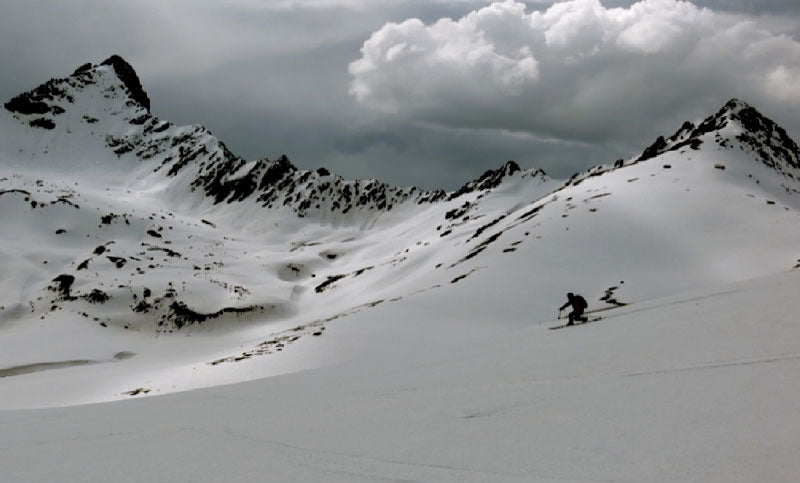
Ski Mountaineering in the San Juan Range
You climb out of your tent surrounded by nothing but blue skies and white peaks – your own private resort. As the sun begins to crawl over the peaks to the east, it’s time to caffeinate, hydrate, and carbohydrate (load). This may sound like a dream, but to Illya Zarkovacki, it was his reality. I sat down with the fellow Chaletan to discuss his latest backcountry experience in which he passes on a lift ticket for a pair of moleskins on Matterhorn Basin.
AR: We spoke a couple months ago while you were planning a backcountry ski trip with one of your friends. Where did you decide to go play?
IZ: My friend Chad Harbaugh and I planned a ski mountaineering trip for late May. Our goal was to spend a few days camping and skiing in the alpine, and to visit an area new to both of us. We decided on Matterhorn Basin in the San Juan’s. We loaded our backpacks and spent a few hours making our way up the Matterhorn Creek trail into the basin and established camp at around 12,000 feet.
Matterhorn Basin is a beautiful high alpine basin flanked by Wetterhorn Peak (14,015) on its western end, and 3 miles to the east is Uncompahgre Peak (14,309). A saddle separates these two peaks – approximately half way between them. This saddle forms the base of the south ridge of Matterhorn Peak.
AR: Sounds like a fun place to make some turns. What was your goal for the first day?
IZ: Aiming for Wetterhorns’ east face first, we awoke to clear weather and a good solid freeze. The only cloud in the sky was sitting right over Wetterhorn, so we didn’t rush to get started. We wanted the sun to soften the snow for good skiing. As the cloud started lifting, we headed for the peak. Surprisingly, the higher we got, the more the snow deteriorated. At around 13,700 ft., we decided we should turn around due to conditions.
AR: That’s a bummer, but better safe than sorry. At least you had about 1,500 feet of elevation change to ski down. What was the issue that caused you guys to turn back?

IZ: East faces can be tricky due to the large amount of solar energy they receive. Specifically with the Wetterhorns’ east face, the steep upper half (around 50 degrees) receives very direct sun angle, and warmed incredibly quickly. The snow actually improved as we skied lower – the opposite of normal – and we enjoyed great turns down the face, with a bonus of skiing the lower bowls all the way to our tent. Après ski, lounging at camp in the spring sun, in such a great location, was truly enjoyable
AR: That still sounds like a great first day in the San Juan’s. How did the second day go?
IZ: We started for Uncompahgre’s west face couloirs on another perfect morning. As we approached the base of the peak, clouds started building, and by the time we were booting the upper flanks of the west face, a storm built with high winds and dropping temperatures. The snow was frozen completely by the time we arrived at the top of the couloir (around 14,000 ft.). Neither of us wanted to ski frozen snow in bad light, so we decided to just wait. We had food and a Jet Boil to make all the hot drinks we wanted. Slowly the weather lifted, so we went to the summit. We left our skis, as the snow was discontinuous above 14,000.

AR: Did it end up being worth the wait?
IZ: Well, after more waiting, the winds finally died down and the sun came back out. With spring skiing, timing can be everything, and ours was perfect. The sun had just baked the snow into perfect corn as we started down, and we ripped telemark turns down the best corn run of my life. Returning toward camp, we climbed another saddle to around 13,000, and enjoyed another run all the way back to our tent.
AR: I find I ask this to everyone after trips. What gear did you use (skis, boots, jacket, etc)? Did you feel you have the proper gear for the kind of activities you were pursuing?
IZ: My ski rig consisted of DPS Wailer 99 Hybrid skis (176cm), Black Diamond 01 Telemark bindings, and Scarpa T1 boots. As far as what I wore to stay dry and comfortable – I wore my Berghaus Vapourlight Hydroloft reversible hoody for active use and warmth. This allowed me to stay active in an outer layer without over heated and having to drop layers in comparison to hard shells. When I needed my hard shell for those cold evenings/mornings at camp, I zipped up my Rab Neutrino Endurance Jacket. I also wore Rab Meco base layers to keep me warm and dry as well. When it came to the main essentials (coffee) and food, nothing really could compare to the Jet Boil Mini Mo. The Mini Mo doesn’t just boil water like other Jet Boil stoves – the valve also allows you to simmer so you can actually cook with it as wll. We melted snow for all of our food, hot drinks, and for clean drinking water. The 8oz fuel bottle was a the right amount for 2 days per person.
AR: Can you give some details on why your ski rig worked so well for this type of skiing environment?
IZ: For starters, I absolutely love the skis. I think they are perfect for this type of terrain. The rocker allows for smooth turn initiation, and reduces tip deflection if the snow gets a funky (like it can with spring skiing). The 99s have less rocker in the tail than the tips, so this gives more edge control and power when finishing turns (and jump turning). I feel I can make any size of turn with them, and they feel super stable at speed. They just feel so intuitive. The BD 01 bindings best feature is the free pivot touring mode. I have toured with it quite a bit, and haven’t had any issues with it, such as icing up. The flex is smooth, and the turns feel stable and predictable. I have had the T1’s for over 8 years now, and love the boots.(01 bindings for about the same amount of time as well). The boots are comfy, powerful and burly, and warm as well. Very rarely have I had cold feet with these. They are a bit heavier than a more touring oriented tele boot, but for spring mountaineering I’ll take the power over a bit of weight savings any day.


The post Ski Mountaineering in the San Juan Range appeared first on Mountain Chalet.

